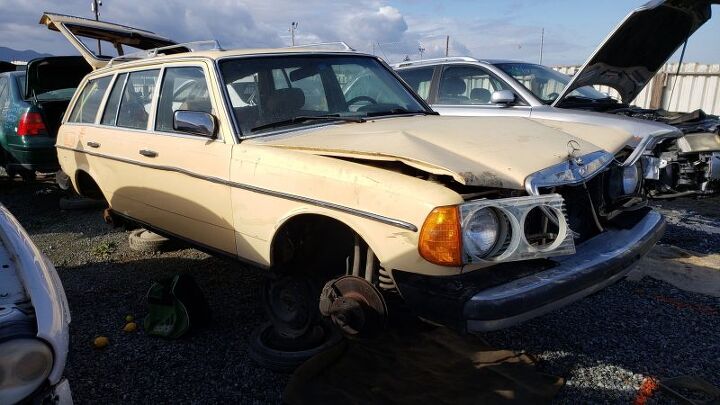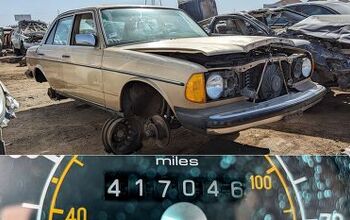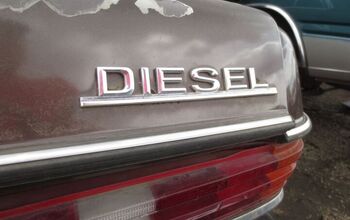Junkyard Find: 1981 Mercedes-Benz 300TD Wagon

The oldest Mercedes-Benz W123 diesels are getting pretty close to 45 years of age, which means that— finally— they’re wearing out and becoming easy to find in the big self-service car graveyards that I frequent. Most of these proto-E-Classes sold in North America were sedans, but the wagons developed something of a cult following and I keep my eyes open for discarded examples.
Here’s an ’81 300TD turbodiesel that seems to have been going strong when it got crashed.
Crunch! In an instant, this wagon lost 95 percent of its resale value. Repairs could have been performed, but the price tag of all the extensive bodywork would have dwarfed the cost of another daily-driver-quality 300TD.
By diesel W123 standards, this car was just getting broken in when the crash happened. Junkyard shoppers tend to grab the instrument clusters out of these cars soon after they hit the yards (for later sale on eBay), so I don’t always get to see the final mileage figure.
Mouse poop and peach pits abound in the engine compartment, so I think this car sat outdoors for a few years after the crash.
This may be the most reliable car engine ever made, period: the OM617 five-cylinder diesel. This one is the frivolously powerful turbocharged version, rated at 119 horsepower and 170 pound-feet; the naturally aspirated version made… well, if you have to ask, you’re not sufficiently patient to drive one.
Because the seats have the immortal MB-Tex fake-leather covering, they show few signs of wear. If you had all your clothes made out of MB-Tex, you’d never need to get a new outfit as long as you lived.
Maybe 15 years ago, many of these cars got destroyed by attempts to convert them to run on waste vegetable oil; if you know what you’re doing, this conversion works very well. Unfortunately, most who took on such projects didn’t know what they were doing, and plenty of diesel Benzes met premature deaths.
If you want to check out more of these Junkyard Finds, you’ll find links to more than 1,800 of them at the Junkyard Home of the Murilee Martin Lifestyle Brand™.

Murilee Martin is the pen name of Phil Greden, a writer who has lived in Minnesota, California, Georgia and (now) Colorado. He has toiled at copywriting, technical writing, junkmail writing, fiction writing and now automotive writing. He has owned many terrible vehicles and some good ones. He spends a great deal of time in self-service junkyards. These days, he writes for publications including Autoweek, Autoblog, Hagerty, The Truth About Cars and Capital One.
More by Murilee Martin
Latest Car Reviews
Read moreLatest Product Reviews
Read moreRecent Comments
- Honda1 Unions were needed back in the early days, not needed know. There are plenty of rules and regulations and government agencies that keep companies in line. It's just a money grad and nothing more. Fain is a punk!
- 1995 SC If the necessary number of employees vote to unionize then yes, they should be unionized. That's how it works.
- Sobhuza Trooper That Dave Thomas fella sounds like the kind of twit who is oh-so-quick to tell us how easy and fun the bus is for any and all of your personal transportation needs. The time to get to and from the bus stop is never a concern. The time waiting for the bus is never a concern. The time waiting for a connection (if there is one) is never a concern. The weather is never a concern. Whatever you might be carrying or intend to purchase is never a concern. Nope, Boo Cars! Yeah Buses! Buses rule!Needless to say, these twits don't actual take the damn bus.
- MaintenanceCosts Nobody here seems to acknowledge that there are multiple use cases for cars.Some people spend all their time driving all over the country and need every mile and minute of time savings. ICE cars are better for them right now.Some people only drive locally and fly when they travel. For them, there's probably a range number that works, and they don't really need more. For the uses for which we use our EV, that would be around 150 miles. The other thing about a low range requirement is it can make 120V charging viable. If you don't drive more than an average of about 40 miles/day, you can probably get enough electrons through a wall outlet. We spent over two years charging our Bolt only through 120V, while our house was getting rebuilt, and never had an issue.Those are extremes. There are all sorts of use cases in between, which probably represent the majority of drivers. For some users, what's needed is more range. But I think for most users, what's needed is better charging. Retrofit apartment garages like Tim's with 240V outlets at every spot. Install more L3 chargers in supermarket parking lots and alongside gas stations. Make chargers that work like Tesla Superchargers as ubiquitous as gas stations, and EV charging will not be an issue for most users.
- MaintenanceCosts I don't have an opinion on whether any one plant unionizing is the right answer, but the employees sure need to have the right to organize. Unions or the credible threat of unionization are the only thing, history has proven, that can keep employers honest. Without it, we've seen over and over, the employers have complete power over the workers and feel free to exploit the workers however they see fit. (And don't tell me "oh, the workers can just leave" - in an oligopolistic industry, working conditions quickly converge, and there's not another employer right around the corner.)














































Comments
Join the conversation
I would fill it with gear and go on a week-long camping trip.
I would fill it with gear and go on a week-long camping trip.